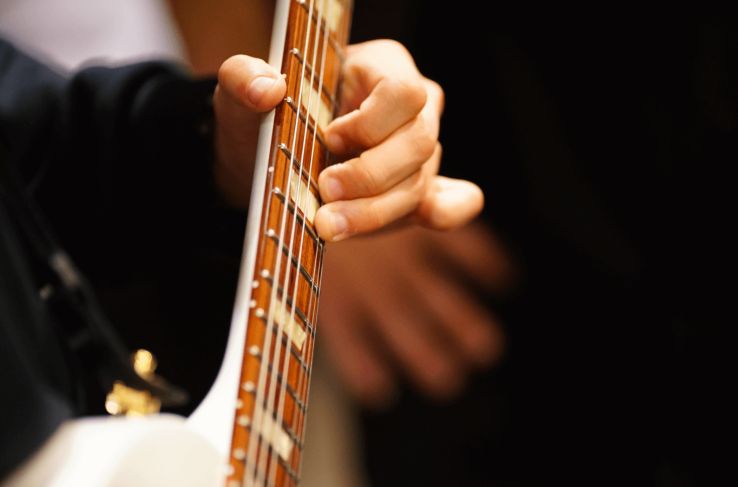Video: Learn 3 Powerful Guitar Soloing Exercises To Massively Improve Your Soloing Skills
I once had a guitar student ask me what he could do to improve his guitar solos with next to zero time to practice.
As he told me about his newborn and crazy work schedule, I saw the doubt in his eyes. He had little hope I could help him.
But his face lit up like a Christmas tree, when I showed him 3 of my best lead guitar soloing ideas that improve any guitar solo.
And you can do them too - in less time than it takes to watch your favorite TV show.
Anytime I use them, creativity literally pours out of me.
Watch this video to see how:
Click on the video to begin watching it.
See my other instructional guitar videos, available to my YouTube subscribers - follow my channel by clicking the button below:
How do you use these guitar solo ideas into your playing?
First, let’s break down each concept into its individual elements… and then work on integrating the elements together.
Here are the lead guitar solo elements I used in each idea:
Lead Guitar Solo Element #1 String Bends
Here is what it takes to consistently bend strings in tune:
- wrap your thumb over the top of the guitar neck and use the web between your thumb and index finger as the pivot point for your arm. Rotate your arm the same way you would if you were turning a doorknob.
- mute excess string noise from the lower in pitch strings. The best way to do it is using your picking hand’s thumb.
Here is how:
Rest your thumb on the strings below the one you are playing. Then, as you change strings, let the thumb slide up and down – muting them.
Use thumb muting for all lead guitar techniques (not just for string bends). This helps you play cleaner and faster with more efficiency and less effort.
(Note: Don't let your thumb hang over the edge of the pick when you do thumb muting. If you do, you will likely get unwanted harmonics.)
Question: “Tom Hess, what if my bends are not in tune?”
Answer: To fix this, get the sound of the note you want to bend to in your ears first.
Like this:
Let’s say you want to bend from the 5th fret up to the 7th fret on the G string.
Before you do the bend – play the 7th fret (the note you plan to bend to) as an unbent note first.
Remember what it sounds like.
Then bend from the 5th fret and stop when your bent note matches the note you just played in the previous step.
Do this exercise many times and soon you will be bending in tune.
Tip: if you accidentally hit the string below (in pitch) the one you are bending, here is how to fix it:
Do string bends using your ring or middle fingers. Use the index finger to touch the thicker string (and mute it). Also, use your guitar pick to push the lower string out of the way when you do a bend.
Lead Guitar Solo Element #2: Vibrato
No doubt about it:
Vibrato is the #1 guitar technique to master if you want to sound great.
Why?
Because notes without vibrato sound boring, lifeless & dull.
I learned this the hard way years ago, when I started to build my speed.
I quickly realized - although I could play fast, something was still missing.
My playing lacked feeling, fire & passion.
How did I finally fix it?
I took guitar lessons with a great teacher.
Here is what he showed me:
Great vibrato is about balancing 2 things: its speed and width.
The wider your vibrato is, the faster it should be to sound good. That’s because fast and narrow vibrato makes your entire playing sound nervous.
And vice versa: the slower your vibrato is, the more narrow it can be to sound good. That’s because slow and wide vibrato makes your “Vibrato” sound like slow bends.
The physical motions of playing vibrato on guitar are very simple.
All you do is wrap your thumb around the neck of the guitar and rotate your forearm/wrist to do vibrato. (Exactly the same as you do when bending strings.)
Like this:

The challenge is training your ears to guide your hands to produce the sound you want to hear.
Watch the video at the top of the page to see & hear what great vibrato should sound like.
If your vibrato doesn’t sound quite right and you can’t easily tell what’s wrong, here is how to troubleshoot it:
First try to put words on what exactly is wrong with your vibrato.
Ask yourself: what exactly, specifically and precisely do you dislike about your current vibrato? (the underlined words are key).
Then practice to refine the sound you hear.
If that doesn't help, the next step is:
… record your vibrato into your computer and listen back to it at half speed.
This helps your ear can pick up many flaws you can’t catch when you listen at normal speed. (And fix them, one at a time.)
Lead Guitar Solo Element #3: Slides
Yep – slides are simple… but:
Most guitarists only use 2 types of slides:
An ascending slide (sliding into a note from a lower pitch)…
… and a descending slide (sliding into a note from a higher pitch).
This is really boring.
Here are 3 more slides I like a lot and recommend you try in your next guitar solo:
- Backslides. To do a backslide, play any note… then slide up in pitch from that note and quickly return back to it. For example: play an E note (9th fret of the G string). Slide up to any fret and quickly return back to the E note.
It doesn't matter (at all) where you slide up to. You do the slide fast and nobody can hear how
Note: a backslide is NOT a “descending slide”. When you do a descending slide, you simply to a lower note from a higher pitch. In a backslide, you slide up AND back to the same note.
- Re-articulation slides. “Re-articulation” is a fancy way of playing “play something again”.
And a re-articulation slide means: you play a note and re-articulate it with a slide. For example: play a D on the 7th fret of the G string… and immediately slide into it from a lower pitch.
(Yes, you can slide into it from a higher pitch too.)
- Slide into a string bend.
The name is self-explanatory on this one.
You slide into any note and then bend from that same note. For example: slide to the 17th fret on the B string and immediately bend from the 17th fret up to the 19th fret.
Only pick the first note (from which you slide to the 17th fret. Don’t hit the 17th fret before the string bend).
Now that you know the biggest lead guitar solo elements and how to practice them, your next task is to integrate them together.
This is where you go from being a guitar player who “knows lots of things”… to a musician who makes your listeners feel what you want them to feel, every time you play a guitar solo.
I can help you with this in my Breakthrough Guitar Lessons.
Here is what we’ll do:
You tell me about your musical goals, guitar playing strengths and weaknesses, problems and challenges. (you do this by filling out a long evaluation from all my new guitar students fill out.)
I then design a customized guitar lesson strategy for you and create your guitar lessons based on that strategy.
As you practice your lessons, I hold your hand every step of the way. You can send me recordings of your playing for feedback, ask me questions (live on video) every week in weekly “Office Hours”, get unlimited email support and a lot more.
If you do your part even half as well as I’ll do mine, I can almost guarantee you’ll become the guitar player you’ve always wanted to be.
To learn more, go to: https://tomhess.net/Guitar
“I was self-taught, and I thought I am so good because I can do this by myself. I wasn’t looking for a teacher but I knew I was looking for something on the internet, and Tom’s lessons came up. I knew instantly that was the way to go. ”
Tom assigns the lessons based on the hundreds of questions you have to answer before you get to be a student. It’s just amazing how he does it. Every single PDF I received has been such a good value. I know if I practice exactly what he says I cannot fail. It helped me realize I can become whatever I want to become. Just set my goal and I know his lessons and way of teaching will get me there eventually. So far so good... I’ll continue doing this as long as possible, and eventually I’ll become a professional player. I’d just like to thank Tom, he’s so thorough, so professional and such a great teacher... and a good person. I want to keep on working with him.
Sigve Solbakken, Bergen, Norway
“July of 2012, I had been managing in a retail store and was kind of reaching this point where I was really getting frustrated because I had been struggling to progress in my guitar playing. I had this mindset that I had to teach myself everything... you know and the best players are all self taught and stuff like that...”
...and I remembered Tom Hess from that book, and I said “You know, it’s time to look this guy up and see what he’s all about.” And it didn’t take me very long to figure out that this is the kind of person that I needed to get on board with.
My playing has definitely improved technique-wise, but probably the most important change I have experienced is just in my overall mindset as a player and as a practicing musician. I just feel like I have a much better frame of mind and a much better idea of where I am going and where my guitar practicing is taking me. Whereas before I just felt like I had to practice everything and I had a whole bunch of stuff going on. It’s a lot more focused now.
Being in the environment that Tom has created with his other students is incredibly motivating. I had always been in my own little shell, kind of just stayed on my own. Coming out here... like when I came out here last year was a big step out of my comfort zone. Getting around all these other musicians... it’s unbelievable how great some of these guys are, not just as players, but as people.Andrew Tintle, Richmond, California USA
 Tom really wants you to exceed, and as a world class virtuoso he knows exactly what the next step for is you. He keeps on pushing you to greater levels, lesson after lesson. Before I started online guitar lessons with Tom Hess, I was an intermediate player, now I can really feel how I will totally dominate as a blues guitar player and an upcoming force in the music industry. Thanks a lot, Tom!
Tom really wants you to exceed, and as a world class virtuoso he knows exactly what the next step for is you. He keeps on pushing you to greater levels, lesson after lesson. Before I started online guitar lessons with Tom Hess, I was an intermediate player, now I can really feel how I will totally dominate as a blues guitar player and an upcoming force in the music industry. Thanks a lot, Tom!
Antony Reynaert, Professional Musician and Guitar Teacher, Belgium
www.antonyreynaert.com


